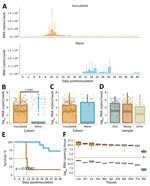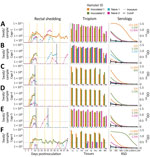Volume 29, Number 10—October 2023
Dispatch
Human-to-Human Transmission of Andes Virus Modeled in Syrian Hamsters
Abstract
Several occurrences of human-to-human transmission of Andes virus, an etiological agent of hantavirus cardiopulmonary syndrome, are documented. Syrian hamsters consistently model human hantavirus cardiopulmonary syndrome, yet neither transmission nor shedding has been investigated. We demonstrate horizontal virus transmission and show that Andes virus is shed efficiently from both inoculated and contact-infected hamsters.
Hantavirus cardiopulmonary syndrome (HCPS) is a sporadic, lethal (>40% fatality rates) zoonotic disease, which in South America is primarily caused by Andes virus (ANDV) (1). HCPS is prevalent where the natural rodent reservoir, the long-tailed colilargo (Oligoryzomys longicaudatus), is present. Zoonotic transmission was thought to occur exclusively through exposure to aerosolized infectious particles from excreta or secreta of infected reservoirs (2). However, unique to ANDV among hantaviruses, person-to-person transmission events have been described, highlighting the potential importance of onward transmission for outbreaks (3–5).
Syrian hamsters (Mesocricetus auratus) infected with ANDV uniquely mimic many aspects of humans with ANDV-HCPS disease (6,7). This model has been crucial for understanding HCPS immunopathology and for developing potential therapeutic treatments (8–11). Although disease modeling in hamsters has been characterized extensively, studies of virus shedding and transmission are absent. In this study, we investigated whether horizontal transmission can be modeled in ANDV-infected hamsters.
To model ANDV shedding and transmission between hamsters, we placed 6 pairs of intranasally-inoculated (200 PFU equivalences of ANDV-9717869) hamsters in clean cages 1 day postinoculation (dpi). To increase contact events, we then introduced 6 pairs of naive hamsters (i.e., contacts) to the inoculated hamsters (6 cages) (Appendix Figure 1). Infectious work was performed within the Biosafety Level 4 facility at the Robert Koch Institute (Berlin, Germany). Animal experiments were approved by Landesamt für Gesundheit und Soziales (permit no. G0142/21). Approval of animal experimentation within Biosafety Level 4 facilities at the Robert Koch Institute was granted by the Regional Office for Health and Social Affairs, Berlin.
We implanted all hamsters with temperature-logging transponders (IPTT-300 Temperature Transponder; Plexx, https://www.plexx.eu). Throughout the experiment, we observed hamsters daily to assess disease signs. Pathognomonic acute disease signs (6,11) were a criterion for euthanasia, and surviving animals were euthanized at 40 dpi. At 27 dpi, one naive animal (c1-n1) was euthanized for unrelated illness (Table 1). Under isoflurane sedation, all animals were routinely weighed and sampled (oral and rectal mucosa and, opportunistically, urine). We collected blood and tissue samples at euthanasia. ANDV RNA copies and nucleocapsid IgG were measured as reported (10).
Irrespective of inoculation route, infected hamsters typically succumb uniformly to disease (6); however, 16.7% of the inoculated cohort survived, potentially because of the lower intranasal infection efficacy (>8-fold inoculum dose required) than that of an intramuscular infection (Table 1). Hamster c6-i2 recovered from moderate disease, and hamster c1-i1 remained healthy. All inoculated hamsters seroconverted (Table 1) and shed abundant ANDV RNA through tested routes until being euthanized (Figure 1, panels A–D; Figure 2; Appendix Figure 2, panel A). Onset of shedding averaged 6 dpi (5 dpi orally and 6 dpi rectally and in urine). Shedding was detected as early as 1 dpi in oral mucosa and urine, and peak shedding occurred consistently 1 day before euthanasia. Horizontal ANDV transmission was evidenced in 45% of the naive cohort (5/11 contacts), but HCPS developed in only 3 hamsters before the predetermined experimental endpoint (Table 1). Survival was significantly different between cohorts (Figure 1, panel E); inoculated hamsters had a median survival of 10.5 dpi and a 7.6-fold greater chance of death than infected contacts (Table 2). However, ANDV was transmitted to 2 other contacts; animal c2-n2 likely evidenced a transmission chain from c2-n1, which potentially had the longest incubation time in this experiment (>18 days). Hamster c2-n2 had abundant and disseminated ANDV RNA in tissue samples (Figure 2, middle column) but was the only infected contact that failed to mount an anti-N antibody response (Figure 2, right column). Animal c6-n2 was likely infected after a late transmission from the persistent shedding of animal c6-i2. Infection of c6-n2 was strongly suggested by the increasing ANDV RNA in rectal mucosa at 40 dpi, which was above intracage cross-contamination levels (Figure 2, panel F, left column). In addition, we detected intermediate loads of ANDV RNA in 4 tissue samples, and this hamster seroconverted (Table 1; Figure 2, panel F, middle and right columns).
Overall, virus replication and dissemination were not different between inoculated animals and infected contacts. Aside from hamster c6-n2, which was likely in an early phase of infection, all infected animals showed virus distribution consistent with previous studies (7,11); lung and liver samples harbored the highest ANDV RNA loads at euthanasia (Figure 1, panel F). Pairwise tissue comparison among cohorts revealed no significant differences in ANDV RNA loads in animals that became infected (Appendix Figure 3). Likewise, after adjusting incubation days in the naive cohort (Appendix Figure 4), shedding loads did not differ between infected animals of either cohort (Figure 1, panels B–C) or by route of shedding (Figure 1, panel D) or shedding duration (Appendix Figure 5). Yet, shedding onset was delayed in contact animals (by 9–30 adjusted incubation days). Other parameters (i.e., periodic weight loss and temperature variation) did not differ significantly between cohorts of infected animals (Appendix Figures 6, 7).
Reports of human-to-human ANDV transmission in recent decades (3–5), which could be driven by specific mutations of ANDV (12), highlight the importance of this phenomenon. In a 2018–2019 outbreak in Chubut Province, Argentina, for example, 33 persons were estimated to be infected after chains of transmissions started from 1 infectious person (5). The potential for human-to-human transmission has drastic implications for public health. Not only is spillover from reservoirs a consideration, but human transmission chains add further complexity in outbreak settings, requiring additional control measures, potential quarantine of infected persons and contacts, and additional precautions in dealing with HCPS patients.
We established an efficient model of ANDV transmission between hamsters and a method for monitoring infection. Moreover, because ANDV shedding loads did not differ by route in infected hamsters and oral shedding began 1 day earlier than with other routes, this model can be further simplified. We describe ANDV shedding kinetics in infected Syrian hamsters, but because of the known difficulties in Andes virus isolation (13), we cannot accurately determine infectious shedding kinetics. Still, infectious particles were shed from >4 of the inoculated animals, 1 of which was a persistent shedder. New World hantaviruses are thought to persistently infect and be intermittently shed from reservoir hosts (2). However, persistent shedding has not been reported in humans or animal models. Although ANDV RNA has been detected in body fluids of humans with HCPS (14), infectious virus has only been isolated from blood (presymptomatic) (1). Unfortunately, because of the study endpoint, we could not evaluate prolonged infectious shedding from an asymptomatic animal (c1-i1).
We also demonstrate that infectious ANDV was serially shed from an infected hamster to a naive hamster, then on to another naive hamster (cage 2). Viral shedding onset was delayed in the naive cohort, particularly for serial transmission. This delay could be because of our rudimentary adjusted incubation day threshold or could be a consequence of the transmission route, the transmitted dose (7), or even virus adaptation (13). Further studies are warranted to elucidate accurate incubation periods, transmission rates, and routes (e.g., contact, fomite, or aerosol). Increasing the experimental time frame also could have improved the results of this study.
Disease could not be verified for 2 infected contact animals. Whether disease would have developed to an extent requiring euthanasia is uncertain. In the case of hamster c2-n2, the high viral abundance and dissemination, paired with a lack of ANDV-specific antibodies could have enabled disease progression; favorable prognosis in humans is correlated with a strong IgG response early in disease (15).
In summary, our results demonstrate that the Syrian hamster is an appropriate model for horizontal transmission of ANDV. We demonstrated clear pathogenesis and further horizontal transmission in contact animals.
Dr. Riesle-Sbarbaro is a veterinarian and a postdoctoral researcher working in the Centre for Biological Threats and Special Pathogens at Robert Koch Institute, Berlin, Germany. Her research interests include comparative infection profiles of filoviruses to study potential reservoir hosts.
Acknowledgment
This work was funded by Robert Koch Institute.
References
- Galeno H, Mora J, Villagra E, Fernandez J, Hernandez J, Mertz GJ, et al. First human isolate of Hantavirus (Andes virus) in the Americas. Emerg Infect Dis. 2002;8:657–61. DOIPubMedGoogle Scholar
- Schountz T, Prescott J. Hantavirus immunology of rodent reservoirs: current status and future directions. Viruses. 2014;6:1317–35. DOIPubMedGoogle Scholar
- Martinez VP, Bellomo C, San Juan J, Pinna D, Forlenza R, Elder M, et al. Person-to-person transmission of Andes virus. Emerg Infect Dis. 2005;11:1848–53. DOIPubMedGoogle Scholar
- Padula PJ, Edelstein A, Miguel SDL, López NM, Rossi CM, Rabinovich RD. Hantavirus pulmonary syndrome outbreak in Argentina: molecular evidence for person-to-person transmission of Andes virus. Virology. 1998;241:323–30. DOIPubMedGoogle Scholar
- Martínez VP, Di Paola N, Alonso DO, Pérez-Sautu U, Bellomo CM, Iglesias AA, et al. “Super-spreaders” and person-to-person transmission of Andes virus in Argentina. N Engl J Med. 2020;383:2230–41. DOIPubMedGoogle Scholar
- Safronetz D, Ebihara H, Feldmann H, Hooper JW. The Syrian hamster model of hantavirus pulmonary syndrome. Antiviral Res. 2012;95:282–92. DOIPubMedGoogle Scholar
- Hooper JW, Larsen T, Custer DM, Schmaljohn CS. A lethal disease model for hantavirus pulmonary syndrome. Virology. 2001;289:6–14. DOIPubMedGoogle Scholar
- Williamson BN, Prescott J, Garrido JL, Alvarez RA, Feldmann H, Barría MI. Therapeutic efficacy of human monoclonal antibodies against Andes virus infection in Syrian hamsters. Emerg Infect Dis. 2021;27:2707–10. DOIPubMedGoogle Scholar
- Prescott J, DeBuysscher BL, Brown KS, Feldmann H. Long-term single-dose efficacy of a vesicular stomatitis virus-based Andes virus vaccine in Syrian hamsters. Viruses. 2014;6:516–23. DOIPubMedGoogle Scholar
- Prescott J, Safronetz D, Haddock E, Robertson S, Scott D, Feldmann H. The adaptive immune response does not influence hantavirus disease or persistence in the Syrian hamster. Immunology. 2013;140:168–78. DOIPubMedGoogle Scholar
- Safronetz D, Zivcec M, Lacasse R, Feldmann F, Rosenke R, Long D, et al. Pathogenesis and host response in Syrian hamsters following intranasal infection with Andes virus. PLoS Pathog. 2011;7:
e1002426 . DOIPubMedGoogle Scholar - Bellomo CM, Alonso DO, Pérez-Sautu U, Prieto K, Kehl S, Coelho RM, et al. Andes virus genome mutations that are likely associated with animal model attenuation and human person-to-person transmission. MSphere. 2023;8:
e0001823 . DOIPubMedGoogle Scholar - Prescott J, Feldmann H, Safronetz D. Amending Koch’s postulates for viral disease: When “growth in pure culture” leads to a loss of virulence. Antiviral Res. 2017;137:1–5. DOIPubMedGoogle Scholar
- Godoy P, Marsac D, Stefas E, Ferrer P, Tischler ND, Pino K, et al. Andes virus antigens are shed in urine of patients with acute hantavirus cardiopulmonary syndrome. J Virol. 2009;83:5046–55. DOIPubMedGoogle Scholar
- Valdivieso F, Vial P, Ferres M, Ye C, Goade D, Cuiza A, et al. Neutralizing antibodies in survivors of Sin Nombre and Andes hantavirus infection. Emerg Infect Dis. 2006;12:166–8. DOIPubMedGoogle Scholar
Figures
Tables
Cite This ArticleOriginal Publication Date: September 15, 2023
Table of Contents – Volume 29, Number 10—October 2023
| EID Search Options |
|---|
|
|
|
|
|
|


Please use the form below to submit correspondence to the authors or contact them at the following address:
Joseph B. Prescott, Robert Koch Institute, Seestrasse 10, 13353, Berlin, Germany
Top